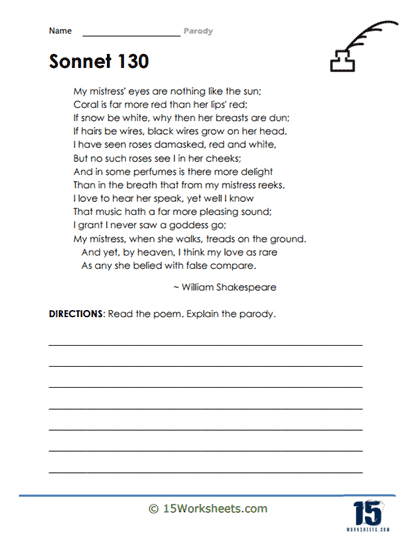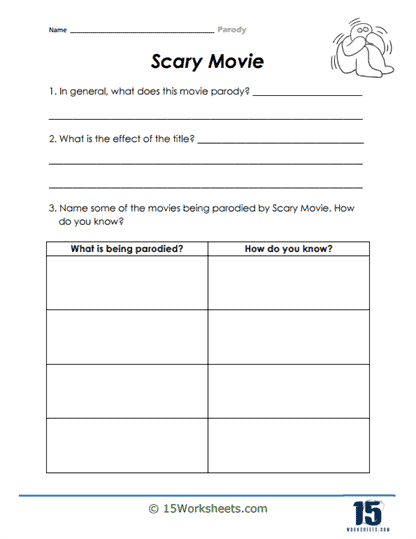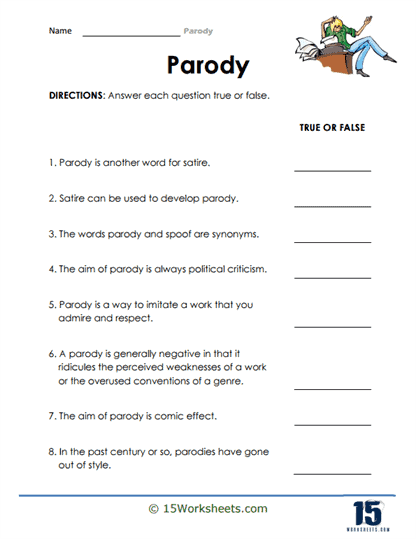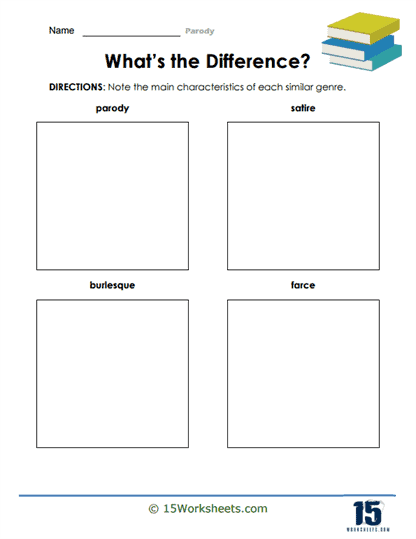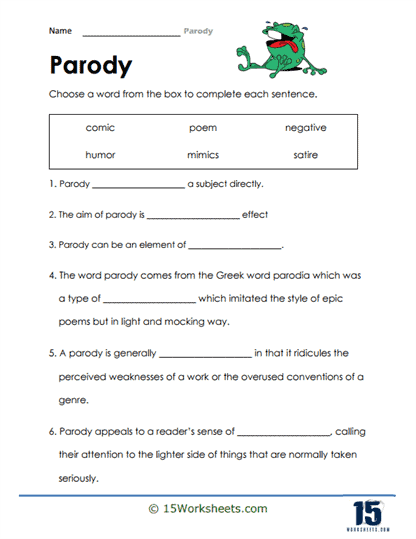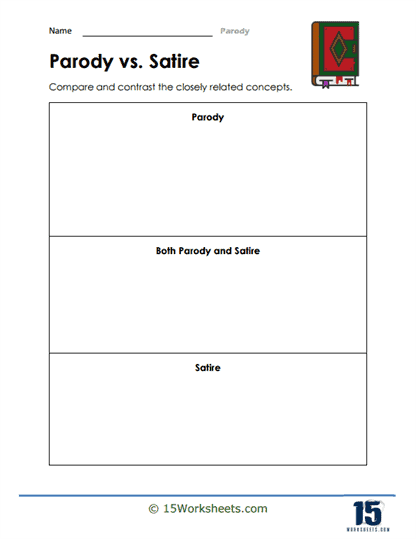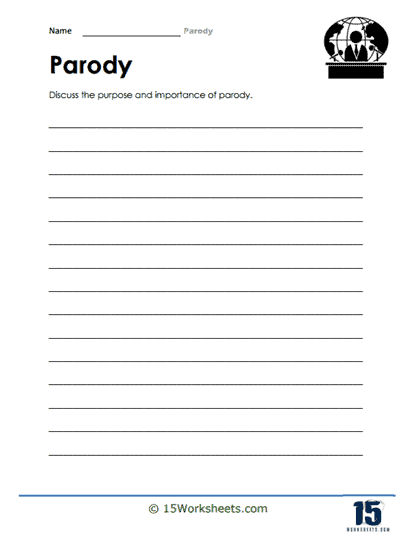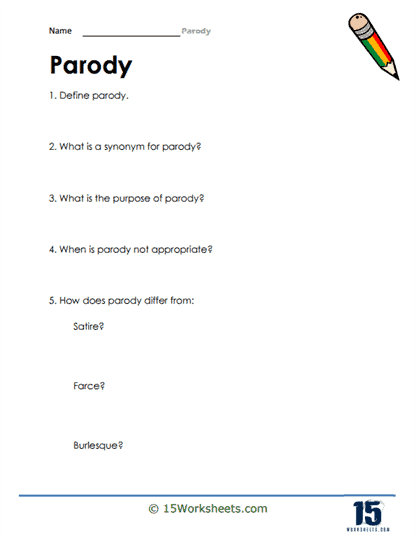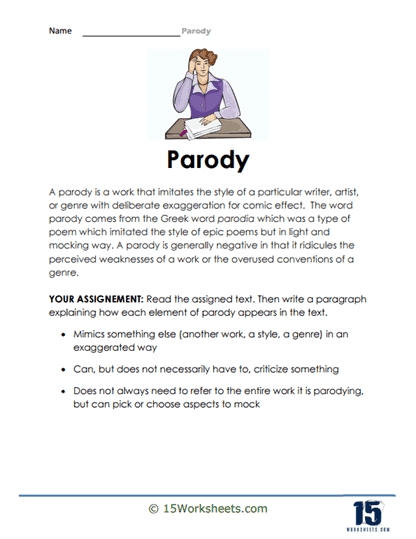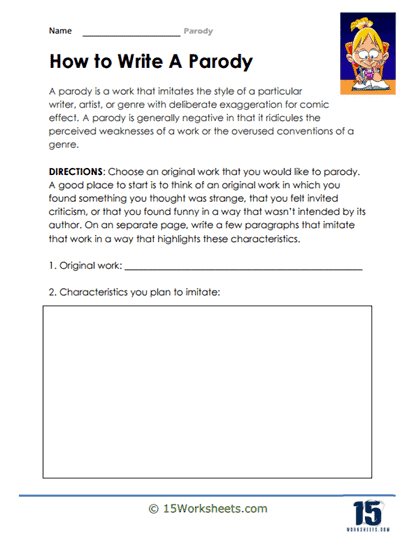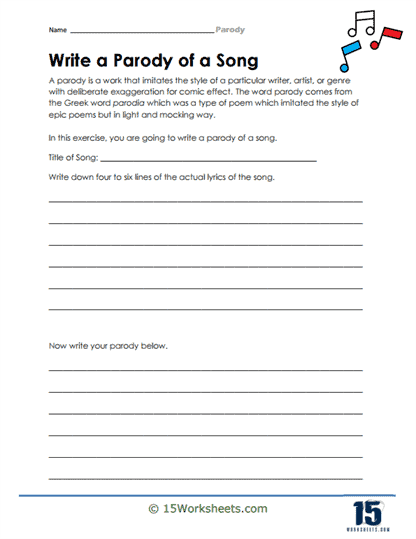Parody Worksheets
All About These 15 Worksheets
Parody, a comedic or satirical imitation of a work, genre, or style, is a delightful and creative form of expression that provides students with valuable insights into humor, cultural critique, and artistic innovation. Understanding parody is not only important for literary and artistic appreciation but also for fostering creativity, critical thinking, and cultural awareness. This collection of 15 worksheets is designed to introduce students to the world of parody, helping them grasp the importance of this humorous and insightful form, recognize its presence in various media, and develop their own parody-writing and analytical skills.
What Are Parody Worksheets?
Parody is a form of satire that imitates the characteristic style of an author or a work for comic effect or ridicule. It’s a humorous or mocking imitation of a particular writing style, genre, or subject matter, and often exaggerates or distorts the original work’s characteristics to create an amusing effect.
These worksheets aim to help students understand and identify the use of parody in various literary contexts. It’s an engaging way for students to learn as it often involves humor and familiar sources. Here’s a breakdown of the types of exercises you might expect:
Definition and Examples – These types of worksheets begin with a definition of parody and provide some straightforward examples, possibly from popular culture or well-known literature. This helps students understand what parody is and how it’s used.
Identification Exercises – Students are given a series of passages and asked to identify which ones are parodies. This encourages them to look for clues in the text, such as exaggerated writing styles or humorous imitation of familiar works.
Comparison Exercises – Here, students are asked to read an original text and its parodic version, then discuss or write about the differences and how the parody version exaggerates or distorts elements for comedic effect.
Creative Writing Prompts – These exercises might involve students creating their own parodies. They could be asked to write a short parody of a well-known fairy tale, popular song lyrics, or a famous scene from a novel. This encourages creativity and a deep understanding of the original text to effectively produce a parody.
Interpretation and Analysis – Students will be asked to analyze why a writer might choose to use parody, and what effect it has on the reader. They might discuss or answer questions about how parody can offer social commentary or critique.
Parody worksheets help students understand this complex literary device by allowing them to explore it from various angles. They learn to identify, analyze, and even create parodies. These skills not only add to their literary understanding but also enhance their creative thinking, making reading and writing more engaging and enjoyable.
What is the Literary Device of Parody?
Parody is a humorous or satirical imitation of a piece of literature, art, or music. Its purpose is not just to mimic, but also to comment on or criticize the work it targets. By copying or slightly altering the original work’s style, characters, or themes, parody pokes fun at, exaggerates, or highlights the original’s flaws or cliches. The defining feature of parody is this act of mimicry, coupled with an intent to entertain or criticize.
Authors use parody as a literary device to engage their audience, often making complex or high-brow works more accessible and enjoyable. It allows them to express critique or commentary about the original work or its broader context, such as societal norms or cultural trends. By engaging their readers with humor, authors can subtly convey their message without seeming overly preachy or academic.
Examples of Parody in Literature
Example 1 – “Don Quixote” by Miguel de Cervantes
Cervantes’ “Don Quixote” is often considered a parody of the popular chivalric romances of his time. The protagonist, Don Quixote, influenced by these romantic stories, sets off on his knightly adventures, treating everyday situations as epic quests and seeing ordinary people as magical beings or threatening villains. His foolish yet earnest behavior humorously mimics and exaggerates the chivalric code, providing commentary on the absurdity and impracticality of these tales.
Through Don Quixote, Cervantes mocks the unrealistic and idealistic narratives of chivalric romances, bringing their flaws into the spotlight. His parody not only entertains but also invites readers to question the influence of literature on one’s perception of reality.
Example 2 – “Pride and Prejudice and Zombies” by Seth Grahame-Smith
In this modern parody, Seth Grahame-Smith takes Jane Austen’s classic novel “Pride and Prejudice” and adds an unexpected twist – zombies. While the original text remains largely intact, Grahame-Smith inserts zombie fights, turning the elegant, manner-focused ladies into deadly zombie hunters.
“Pride and Prejudice and Zombies” is a playful take on Austen’s original work, retaining its societal critique while adding elements of modern horror and action. This clever juxtaposition allows Grahame-Smith to comment on the rigidity and pretensions of Regency society, demonstrating that parody can mix genres to create something fresh and engaging.
Example 3 – “The Wind Done Gone” by Alice Randall
“The Wind Done Gone” is a parody and a critical response to “Gone with the Wind” by Margaret Mitchell. This novel retells the original story from the perspective of Cynara, a formerly enslaved woman and half-sister to Scarlett O’Hara, the original novel’s protagonist.
By retelling the story from a different perspective, Randall critiques the romanticized portrayal of slavery in the original novel. Her parody sheds light on the experiences of the enslaved characters, which were largely sidelined in Mitchell’s narrative, thereby challenging the original text’s racial politics.
Benefits Of Parody Worksheets For Students
Exploring the world of parody through this collection of 15 hilarious worksheets offers students an opportunity to develop essential skills in cultural critique, creative expression, humor, media literacy, and cultural awareness. Parody is a dynamic and engaging form of artistic expression that invites students to explore the boundaries of humor and satire.
By engaging with these exercises and activities, students not only enhance their academic abilities but also gain valuable tools for creative expression, critical analysis, and an understanding of the role of humor in society and culture. The benefits of studying parody extend far beyond the classroom, empowering students to be more creative, discerning, and culturally aware individuals in an increasingly complex and comedic world.





